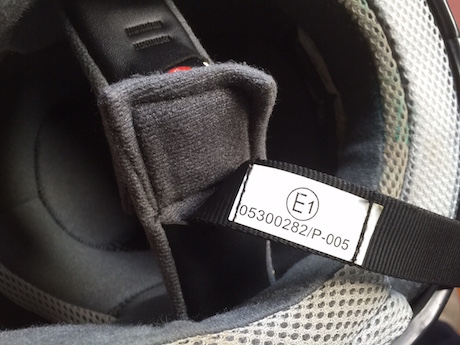Are the new international motorcycle helmet laws in Queensland and Victoria unclear, unfair and even un-constitutional?
Helmet and rider rights advocate Wayne Carruthers has compiled this comprehensive and, at times, confounding report on the new laws.
It just goes to show how convoluted and disparate our helmet laws are and the desperate need for uniformity across state boundaries. and simplicity. Wayne has started a helmet petition which you can sign here.
Also, check out the Australian Motorcycle Council’s submission to the Senate’s road safety inquiry.
- By Wayne Carruthers
Now that Victoria has joined Queensland in approving UNECE 22.05 helmets so perhaps it is time to review the new regulations and see how they measure up against the obligations of any state in writing regulations.
The obligations for all States and Territories are contained in a number of areas, the three principal areas are:
- The Constitution
- Mutual Recognition Legislation
- COAG Good Governance Agreements
We will start off on a positive note and look at where the two states are in agreement, the UNECE Helmet requirements.
Both Queensland and Victoria are to be applauded for staying with the precise UNECE standard and its approval and labelling requirements.
The problem for both States is that UNECE helmets are not legal to sell due to a drafting error in the 1990 ACCC CPN 9 Product Safety Standard. Previous Trade Practices Act proclamations stated: “Protective helmets for motor cyclists for use on public roads”. ACCC CPN9 states “Protective helmets for motor cyclists” which renders it illegal for retailers to sell helmets to other standards for other than public road use.
The external labels and stickers seen on many helmets in online ads are nothing more than advertising stickers and in many cases attempt to show the approval to multiple standards such as the US DOT and UNECE. They are however meaningless. It is the internal labelling (see pic below) as per the UNECE specifications which determine whether a helmet is legal to wear.
Now that we have the only common aspect to the Queensland and Victorian rules out of the way, let us look at the regulations for each from a good governance and mutual recognition perspective.

Queensland
The Constitution
The Queensland Regulations pose no questions on constitutionality other than a small variance from the Commonwealth in the definition of AS1698. The Commonwealth AS1698 mandatory standard should really have been referenced rather than the voluntary standard. The Queensland Road Rules however does not require the Commonwealth mandated labelling after the point of sale. This is specified in another clause of the Road Rules.
Mutual Recognition Obligations
The Mutual Recognition Legislation signed between the Commonwealth, NZ and the States imposes requirements of recognition of each others laws in some respects extending the provisions of the Australian Constitution.
For riders from states other than Queensland the Queensland regulations pose no real problems, no additional requirements are added beyond the content of the relevant standards and so Queensland receives a tick on that aspect.
However there is a problem with recognition of interstate medical exemptions and NZ riders as there is no provision for NZ riders to be able to wear helmets of the other standards allowed in NZ and no recognition of medial exemptions granted in a rider’s home state.
All states and the Commonwealth are in violation of MRA provisions by not recognising the legality of sale of helmets to the other standards allowed in NZ and by failing to ensure restrictive use regulations do not make allowing sale of helmets to the other standards meaningless.
COAG Good Governance
The COAG Good Governance agreements require a number of steps to be taken when considering new or revised regulations, we will look at 3 of the requirements.
- Writing regulations in plain English: Here Queensland passes with flying colours, it is simple, straight forward and easily understood. In fact the entire Road Rule 270 is only 155 words
- Consultation with stakeholders: Here unfortunately Queensland failed as there was no draft regulation put out for public and stakeholder discussion. However perhaps we can have a little leniency in this specific regulatory change. The regulatory change was clearly one the Queensland Department of Transport and Main Roads was preparing along with other changes and the announcement of the change was brought forward for political reasons. We can all agree to disagree with any Government of the day but it is also the right of any government to put changes requested by the public in place and then point to them in any subsequent election
- Consultation with other states: Again here Queensland failed to put the changes out to consultation with the other states and failed to ensure the changes were also implemented by the other states. COAG good governance agreements state that states should not make unilateral changes but should only make changes when all states agree and implement changes in a coordinated manner. Perhaps on this we could again show some leniency in that the end result a plain language sensible regulation was achieved and the path forward was laid out for other states. Overall Queensland should be given a pass but with the proviso that due processes should be followed in the future and further changes made to accommodate variations in regulations in NZ and recognise interstate medical exemptions.
- Consistency with previous regulations: Here Queensland passes with flying colours as there is no change to the regulation of the previous standards allowed.
Victoria
The Constitution
Victoria shows scant regard for the constitution, there is the same small variance between the Commonwealth with the definition of AS1698 as in Queensland but it is in other areas Victorian regulations are in conflict with the constitution
The first is that the adoption of JAS-ANZ certification for AS1698-2006 helmets, it imposes a levy on riders resident in other States contrary to Section 92. In addition to the above the regulation is in conflict with Sections 92 and 117 as it restricts free movement between the states and discriminates against riders from other States by not recognising either the variations in regulations between states or the medical exemptions granted to riders in their home State.
Mutual Recognition Obligations
Victoria has no provisions in the helmet regulations to provide for any variations in regulations between States or NZ.
Queensland regulations do not require external standard stickers on helmets and Victoria and the other States need to provide for this in their regulations. NZ has approved the use of other standards such as BSI, JIS DOT and NZ riders have every right to expect to be able to use their helmets when travelling in Australia. Victoria makes no such provisions in their regulations, nor do they provide for recognition of medical exemptions granted to riders in their home state.
On this criteria Victoria receives a fail.
- Writing regulations in plain English: During the period 1999 to the present VicRoads have progressively made the regulations more verbose and more ambiguous yet the only real change in standards have been the addition of AS1698-2006 in 2012 and now UNECE in 2015. On a simple word count the position is : 1992 Reg – 176 words, 1999 Reg – 187 words, 2009 Reg – 320 words, 2012 Reg – 430 words. Victoria fails completely. During a period the obligation was to simplify regulations they have done the opposite.
- Consultation with stakeholders: There was no discussion paper or draft regulation put out for public or stakeholder comment, there was no political imperative to make rushed changes to the existing regulation so there are no extenuating circumstances to justify the change. Victoria receives a complete fail. Victoria continues to ignore the obligations under the COAG Good Governance Agreements.
- Consultation with other states: As far as can be determined Victoria did not put up a discussion paper to the other States or present any information to COAG, it can only be concluded that Victoria has failed to honour this agreement and commitments to good governance. Fail, what else can be said.
- Consistency with previous regulations: Here Victoria is a complete fail. From 1983 until 1992 the Victorian Road Rules Helmet Standards proclamations mirrored the Federal Trade Practices proclamations. From 1999 onwards this practice was abandoned and Victoria effectively changed the labelling requirements for helmets already in use. In 1999 Victoria also began differentiating between helmets manufactured in Australia and helmets imported. Whether helmets are imported or manufactured here is completely irrelevant to whether a helmet meets the required standards.
Each subsequent proclamation has had variations in the regulations for existing standards, they are small and associated with labelling but effectively re regulate helmets already in use.
The 1999 regulation reverted from the Commonwealth mandated definition of an AS1698 helmet with regard to helmet labelling to the AS1698 voluntary standard definition, the 2012 regulations then noted that an Australian standard was considered to be in force only when mandated by the ACCC so in effect reverted back to the ACCC CPN 9 definition.
The 2015 regulation again reverts the AS1698 definition back to the voluntary standard and activates the JAS-ANZ labelling requirement where the 2012 regulation noted JAS-ANZ labelling would not be active until the AS1698-2006 standard was applied as part of a mandated product safety standard by ACCC under ACL.
All up, Victoria receives a big fail on this criteria.
Conclusion
Queensland deviates from the processes and procedures required under the various intergovernmental agreements and has not allowed for NZ riders the result is a reasonable regulation. Meanwhile, Victoria has displayed complete disregard for all intergovernmental agreements, produced a convoluted and complex regulation while treating stakeholders with contempt.
As has been stated by someone other than this writer, it is the arrogance of Victoria and the ethical aspect that is missing in action.
The Victorian Gazette lists three standards, only one of which is legal to sell, but you can’t buy one of those, because nobody makes makes them. The others require a rider to be a party to an illegal transaction.
NSW is still proposing an additional Australia only sticker for UNECE helmets and the ACCC has a preferred option of vacating the national standard role. We can only wait in horror of what may be about to arrive given these possibilities.





